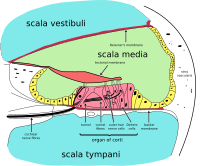
Photo from wikipedia
The pons is one of the earliest affected regions in patients with synucleinopathies. We aimed to investigate the diagnostic value of measuring pontine damage using diffusion tensor imaging (DTI) in… Click to show full abstract
The pons is one of the earliest affected regions in patients with synucleinopathies. We aimed to investigate the diagnostic value of measuring pontine damage using diffusion tensor imaging (DTI) in these patients. We enrolled 49 patients with Parkinson's disease (PD), 16 patients with idiopathic rapid eye movement sleep behavior disorder (iRBD), 23 patients with multiple system atrophy (MSA), and 39 healthy controls in this study. All the participants underwent high-resolution T1-weighted imaging and DTI. Mean diffusivity (MD) and fraction anisotropy (FA) values in the pons were calculated to characterize structural damage. The discriminatory power of pontine MD and FA values to differentiate patients with synucleinopathies from healthy controls was examined using receiver operating characteristics (ROC) analyses. Compared to healthy controls, patients with PD, iRBD, and MSA had increased MD values and decreased FA values in the pons, although no correlation was observed between these DTI measures and disease severity. The ROC analyses showed that MD values in the pons had a fair discriminatory power to differentiate healthy controls from patients with PD (area under the curve [AUC], 0.813), iRBD (AUC, 0.779), and MSA (AUC, 0.951). The AUC for pontine FA values was smaller than that for pontine MD values when differentiating healthy controls from patients with PD (AUC, 0.713; p = 0.054) and iRBD (AUC, 0.686; p = 0.045). Our results suggest that MD values in the pons may be a useful marker of brain stem neurodegeneration in patients with synucleinopathies.
Journal Title: Journal of neuroscience research
Year Published: 2021
Link to full text (if available)
Share on Social Media: Sign Up to like & get
recommendations!